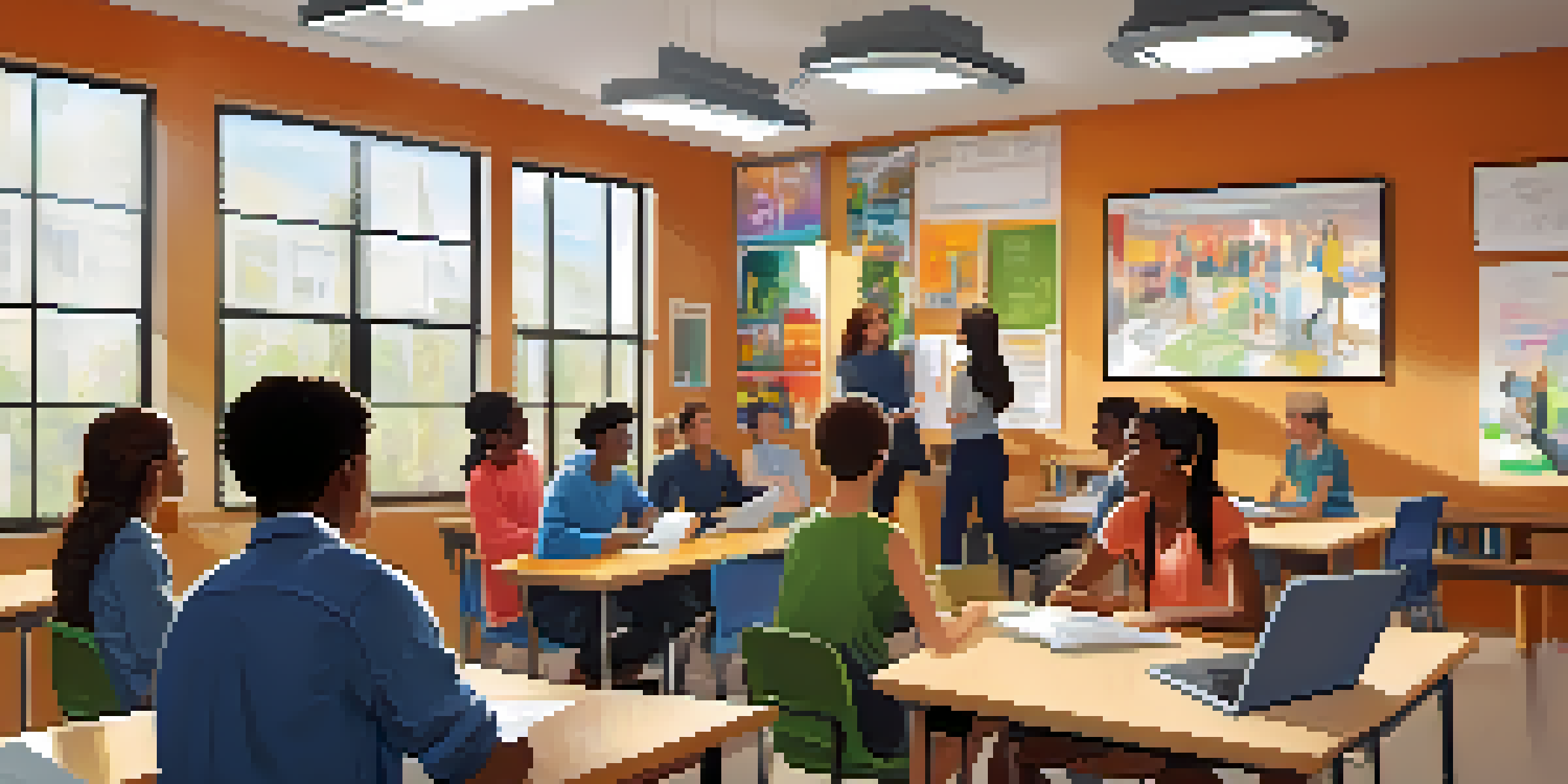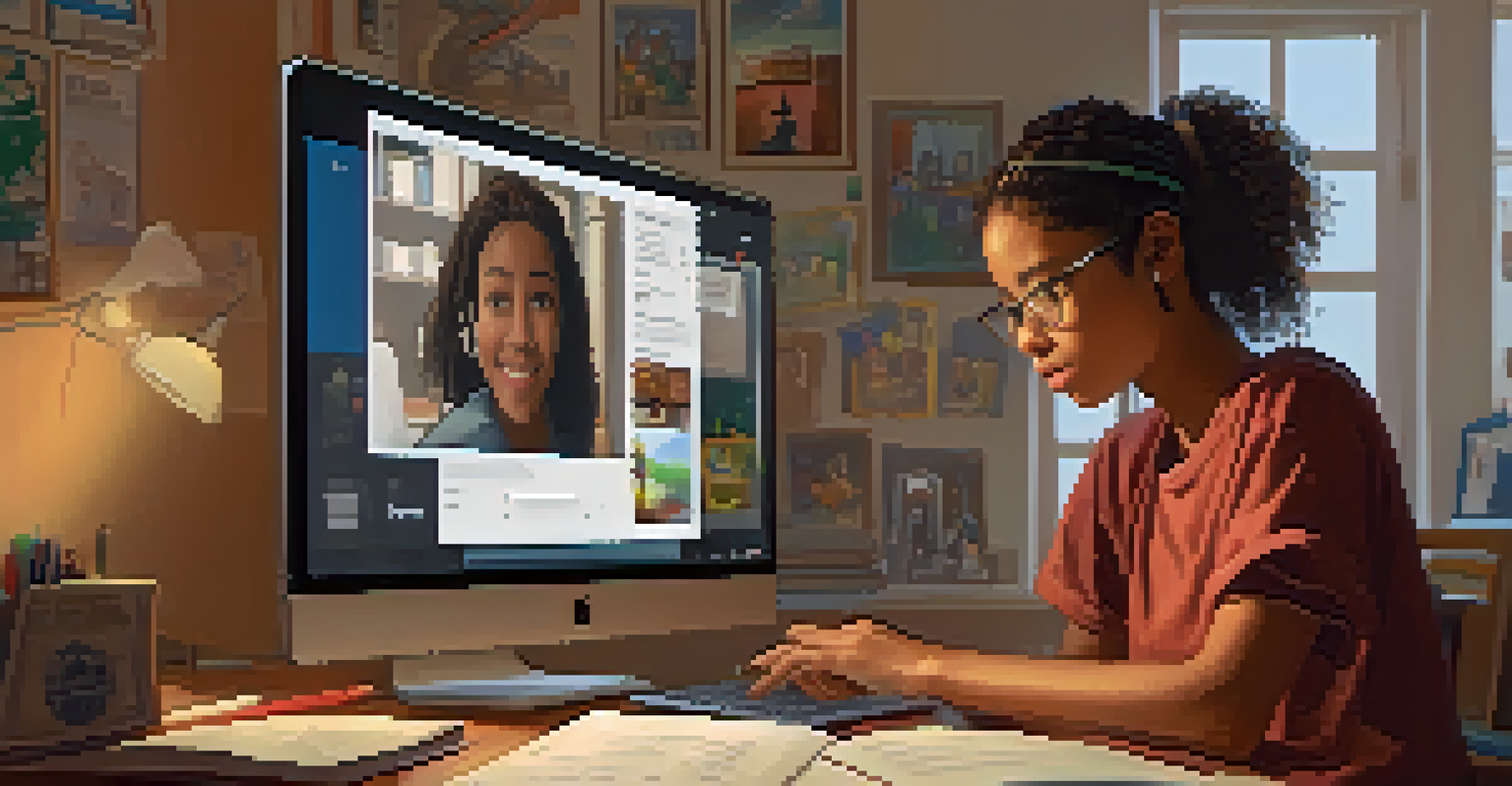Flipped Classroom: Innovative Approaches to Student Assessment

Understanding the Flipped Classroom Model
The flipped classroom model is a teaching approach that reverses traditional learning. Instead of introducing new content during class time, students engage with learning materials at home. This allows in-class time to be dedicated to interactive discussions and hands-on activities. The goal is to create a more engaging and student-centered learning environment.
Education is not the filling of a pail, but the lighting of a fire.
In a typical flipped classroom, students might watch instructional videos or review readings before attending class. This preparatory work equips them with the foundational knowledge they need to participate actively in discussions. As a result, teachers can spend more time addressing individual student needs during class hours. This model encourages students to take ownership of their learning journey.
Overall, the flipped classroom sets the stage for innovative assessment methods. By shifting the focus to student engagement and participation, educators can better gauge understanding and application of knowledge. This transformation paves the way for more meaningful evaluations that reflect real learning outcomes.
Shifting Assessment Paradigms in Education
Traditional assessment methods often rely on standardized tests that may not accurately reflect a student's understanding. With the flipped classroom model, assessments can take on many forms, allowing for a more holistic view of student learning. For instance, teachers can use projects, presentations, or collaborative activities to evaluate comprehension. These methods not only assess knowledge but also critical thinking and teamwork skills.

This shift encourages educators to design assessments that are not just about memorization but also about application. For example, instead of answering multiple-choice questions, students might create a video explaining a concept. This approach promotes creativity and allows students to demonstrate their understanding in unique ways. Such assessments can be more enjoyable and fulfilling for both students and educators.
Flipped Classrooms Enhance Engagement
The flipped classroom model allows students to engage with learning materials at home, freeing up in-class time for interactive discussions and hands-on activities.
Moreover, this paradigm shift fosters a growth mindset among students. By focusing on formative assessments, students receive ongoing feedback rather than a single grade. They can reflect on their learning and make adjustments, which enhances their motivation and engagement. This continuous improvement mindset is crucial for lifelong learning.
The Role of Technology in Flipped Classrooms
Technology plays a vital role in the success of the flipped classroom model. Tools like video platforms, learning management systems, and collaborative software provide a wealth of resources for students. These technologies enable educators to create engaging content that students can access anytime, anywhere. This flexibility is particularly beneficial for diverse learning styles and paces.
The greatest sign of a success for a teacher is to be able to say, 'The children are now working as if I did not exist.'
For instance, platforms like Khan Academy or YouTube can host instructional videos that cater to different subjects and skill levels. Students can pause, rewind, or revisit these materials as needed, allowing for personalized learning experiences. Additionally, interactive quizzes and online discussions can deepen understanding and foster a sense of community among students.
However, it's essential to ensure that all students have access to the necessary technology. Schools and educators must be mindful of potential disparities in access to devices or the internet. By providing resources and alternatives, such as printed materials or access to school facilities, educators can ensure that all students benefit from the flipped classroom experience.
Engaging Students Through Active Learning
Active learning is at the heart of the flipped classroom model, emphasizing student participation and collaboration. This approach encourages learners to engage with the material actively and apply their knowledge in meaningful ways. For example, during class time, students might work in groups to solve real-world problems or debate various viewpoints on a topic.
Such activities not only make learning more enjoyable but also promote critical thinking and collaboration. When students work together, they can learn from each other, gaining different perspectives and insights. This collaborative environment helps to build essential social skills that are vital for success in the 21st century.
Diverse Assessments Foster Growth
Shifting from traditional assessments to diverse methods, such as projects and peer evaluations, provides a more holistic view of student understanding and promotes critical thinking.
Furthermore, active learning fosters a sense of accountability among students. When they are involved in their education, they feel a greater responsibility to contribute to discussions and projects. This sense of ownership can lead to increased motivation and a more profound commitment to learning.
Assessing Student Understanding with Formative Techniques
Formative assessment techniques are essential in the flipped classroom model. Unlike summative assessments, which evaluate learning at the end of a unit, formative assessments provide ongoing insights into student understanding. These can include quick quizzes, peer assessments, or exit tickets that gauge comprehension during class.
By using formative assessments, educators can identify areas where students may be struggling and adjust their teaching methods accordingly. For example, if several students find a concept challenging, the teacher can revisit it with a different approach. This adaptability ensures that all students receive the support they need to succeed.
Additionally, formative assessments encourage a feedback-rich environment. Students can receive immediate feedback on their performance, allowing them to reflect and improve continuously. This process not only enhances learning but also builds confidence, as students see their progress over time.
Peer Assessment and Collaborative Learning
Peer assessment is another innovative approach to student evaluation in the flipped classroom. This technique allows students to evaluate each other's work, fostering a sense of collaboration and community. By engaging in peer assessment, students develop critical evaluation skills while gaining insights into different perspectives.
For instance, after completing a group project, students can provide constructive feedback to their peers. This process encourages them to think critically about their work and that of others, promoting deeper learning. Additionally, it helps students articulate their thoughts and reasoning, essential skills in both academic and real-world settings.
Technology Supports Personalized Learning
Utilizing technology in the flipped classroom enables personalized learning experiences, ensuring that all students can access resources suited to their individual needs.
Moreover, peer assessment cultivates a supportive learning environment. Students feel more comfortable sharing their ideas and receiving feedback from classmates rather than solely relying on the teacher. This collaborative atmosphere can lead to stronger relationships and a sense of belonging within the classroom.
Reflective Practices for Continuous Improvement
Reflection is a crucial component of the flipped classroom, both for students and educators. By encouraging students to reflect on their learning experiences, educators can help them identify strengths and areas for improvement. Reflective practices can take many forms, such as journals, discussions, or self-assessments.
For example, students might write a reflection on what they learned during a project and how they can apply it in the future. This process allows them to connect their learning to real-life situations, enhancing retention and understanding. Additionally, reflection helps students develop metacognitive skills, enabling them to become more aware of their learning processes.

Educators can also benefit from reflective practices by assessing their teaching methods and strategies. Through self-evaluation and feedback from students, teachers can identify what works well and what needs adjustment. This commitment to continuous improvement ultimately leads to a more effective and engaging learning environment for all.